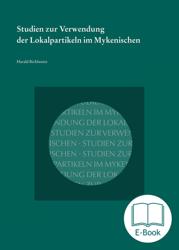Die Lokalpartikeln (Adverbien, Präpositionen, Präverbien) des Mykenischen waren seit 30 Jahren nicht mehr Gegenstand einer eingehenderen Untersuchung. Das vorliegende Buch versucht, diese Lücke zu füllen, indem noch einmal alle potentiellen Belege für Lokalpartikeln im Mykenischen systematisch untersucht und bewertet werden. Da aufgrund des Charakters der Linear-B-Schrift viele Wortformen nicht eindeutig gedeutet werden können, müssen weiterhin zahlreiche Lesungen offen bleiben. Ohne (umfangreiche) Neufunde an Texten sind für diesen Teilaspekt der Mykenologie grundlegende neue Erkenntisse vorläufig nicht zu erwarten.
The ‘Studies on the use of local particles in Mycenaean Greek’ close a gap in the analysis of the Mycenaean Greek language. The book offers the first comprehensive analysis of this special part of the lexicon in Mycenaean Greek. The so called local particles can surface as prepositions, preverbs or adverbs. In Mycenaean Greek the use of local particles as prepositions is the most frequent one. As adverbs and preverbs they appear much less often, which is due mainly to the character of the Mycenaean Linear B texts: They are predominantly of an economic character in the farther sense of the word and show an often monotone style making hardly anytime any use of verbal expressions. The necessity to use prepositions is further restricted by the fact that the functions of the cases locative, ablative, and instrumental inherited from Proto-Indo-European are still more or less intact and can thus still be used without the prepositions usual, often necessary or even indispensible in alphabetical Greek.
Thus the prepositions used as first members in compound nouns form the biggest part of the corpus of word-forms analysed in this study. Of these compounds the majority are personal names. This obviously shows a big difference between Mycenaean and alphabetical Greek as far as the distribution of the local particles on their different uses is concerned and as far as the relative quantity of eauch local particle is concerned. Some prepositions used throughout and frequently in alphabetical Greek do not show up (yet) in Mycenaean Greek. All in all some 170 (including writing variants vel sim. about 200) word-forms, which might contain a local particle judging from the way they are spelled, have been analysed in the present study. For most of them such an analysis has been put forward before. These former propositions have been checked thoroughly and where possible a final judgement was given. Until now the existence of 22 local particles has been discussed for Mycenaean Greek. For some of these presumably 22 local particles potentially to be found in Mycenaean word-forms no positive evidence could be put forward so far, most of them can be discerned quite clearly, however. More than half of the more than 170 examined word-forms contain one (exceptionally even two) of these 22 local particles for sure or at least probably.
In spite of the well-known restrictions always applying to studies of Mycenaean Greek texts because of the small size and the lopsidedness of the corpus, this study once more shows clearly the greater archaicity of Mycenaen compared to alphabetical Greek. It offers a new basis for comparative studies and studies in Greek language history by Indoeuropeanists, mycenologists and philologists of the Greek language.
„Insgesamt leistet das Buch nicht nur einen wesentlichen Beitrag zur etymologischen Untersuchung
der mykenischen Lokalpartikeln, sondern vor allem auch zur griechischen Namenkunde. (...) Bichlmeiers Monographie stellt
eine gute Grundlage für eine weitere Beschäftigung mit den mykenischen Lokalpartikeln dar.“
Laura Sturm
In:Das Altertum. 2015, Band 60, S. 65-67.
„This is a very interesling book in which the author exhibits an impressive knowledge of Mycenology as weil as Greek and IE linguistics. I highly recommend it to those interested in Mycenaean Greek and/or in any IE branch.“
Von José Miguel Jiménez Delgado
In: BMCR 2014.12.19 <
http://brynmawr.us1.list-manage1.com/track/click?u=c302ee634698194cc76ef8a8b&id=c6aefe8cfb&e=8f7380a1b5>
on the BMCR blog
Bryn Mawr Classical Review 2014.12.19
geb. 1969 in Passau
Abitur 1988 am Hanns-Seidel-Gymnasium, Hösbach, Lkr. Aschaffenburg
03/1989‒10/1990 Zivildienst beim Roten Kreuz, Aschaffenburg
ab WiSe 1990/91 Studium der Slavistik und Indogermanistik an der Julius-Maximilians-Universität Würzburg
SoSe 1995 Auslandssemester an der Karls-Universität, Prag
1.12.1997 Magister Artium mit der indogermanistischen Magisterarbeit „Die ablativischen Adverbien im R̥gveda“
1.4.1998 – 31.7.2002:
Wissenschaftlicher Mitarbeiter am Lehrstuhl für Vergleichende Sprachwissenschaft in Würzburg (halbe Stelle)
1.8.2002 – 30.9.2004:
Wissenschaftlicher Mitarbeiter am Lehrstuhl für Vergleichende Indogermanische Sprachwissenschaft und Indoiranistik der Universität des Saarlandes (ganze Stelle)
15.4. – 14.7.2005:
Wissenschaftlicher Mitarbeiter am Lehrstuhl für Germanistik – Ältere Abteilung der Universität des Saarlandes (ganze Stelle) und Mitarbeit am DFG-Projekt „Straßen und Namen“
1.10.2005 – 30.6.2007:
Wissenschaftlicher Mitarbeiter am Lehrstuhl für Germanistik – Ältere Abteilung der Universität des Saarlandes (halbe Stelle) und Mitarbeit am DFG-Projekt „Straßen und Namen“
Frühjahr 2008:
Wissenschaftlicher Mitarbeiter am Akademievorhaben „Prosopographie der mittelbyzantinischen Zeit“ der Berlin-Brandenburgischen Akademie der Wissenschaften (Werkvertrag)
1.7.2007 – 14.12.2008:
Wissenschaftlicher Mitarbeiter am Akademievorhaben „Prosopographie der mittelbyzantinischen Zeit“ der Berlin-Brandenburgischen Akademie der Wissenschaften (halbe Stelle)
1.8.2007 – 14.12.2008:
Wissenschaftlicher Mitarbeiter am VW-Projekt „Edition des Mittelarmenischen Wörterbuchs von Josef Karst“ am Seminar für Indogermanistik und Allgemeine Sprachwissenschaft der Martin-Luther-Universität Halle-Wittenberg (halbe Stelle)
15.12.2008 – 31.3.2009:
Wissenschaftlicher Mitarbeiter am Akademievorhaben „Prosopographie der mittelbyzantinischen Zeit“ der Berlin-Brandenburgischen Akademie der Wissenschaften (ganze Stelle)
1.4.2009 – 30.6.2009:
Wissenschaftlicher Mitarbeiter am Akademievorhaben „Prosopographie der mittelbyzantinischen Zeit“ der Berlin-Brandenburgischen Akademie der Wissenschaften (halbe Stelle)
seit 1.4.2009:
Wissenschaftlicher Mitarbeiter am Akademievorhaben „Etymologisches Wörterbuch des Althochdeutschen“ der Sächsischen Akademie der Wissenschaften zu Leipzig, Arbeitsstelle Jena (50%)
1.8.2009 – 30.09.2010:
Wissenschaftlicher Mitarbeiter am VW-Projekt „Edition des Mittelarmenischen Wörterbuchs von Josef Karst“ am Seminar für Indogermanistik und Allgemeine Sprachwissenschaft der Martin-Luther-Universität Halle-Wittenberg (Werkvertrag)
20.04.2010:
Einreichung der Dissertation „Ablativ, Lokativ und Instrumental im Jungavestischen: Ein Beitrag zur altiranischen Kasussyntax“
13.07.2010:
Promotionsprüfung: mündliche Prüfung: summa cum laude; Arbeit: opus eximium
seit 1.1.2013:
Wissenschaftlicher Mitarbeiter am Akademievorhaben „Digitaler Familiennamenatlas Deutschlands“ der Mainzer Akademie der Wissenschaften und der Literatur (50%)
Forschungsschwerpunkte:
Onomastik (bes. ‚alteuropäische Hydronymie‘, Ortsnamen in Deutschland, slawische Familiennamen in Deutschland), Indogermanistik, Altiranistik (bes. Jungavestisch), Mykenisch
onomastics (esp. Old European hydronymy, place-names in Germany, Slavic family-names in Germany), Indo-European lingulistics, Old Iranian studies (esp. Young Avestan), Mycenaean Greek


 Preface
Preface